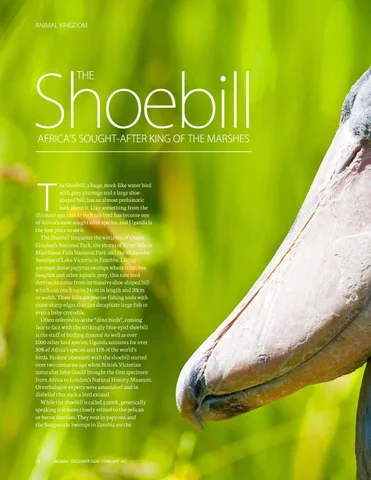ANIMAL KINGDOM
AFRICA’S SOUGHT-AFTER KING OF THE MARSHES
T
he Shoebill, a huge, stork-like water bird with grey plumage and a large shoeshaped bill, has an almost prehistoric look about it. Like something from the dinosaur age, this 55 inch tall bird has become one of Africa’s most sought after species, and Uganda is the best place to see it. The Shoebill frequents the wetlands of Queen Elizabeth National Park, the shores of River Nile in Murchison Falls National Park and the Mabamba Swamps of Lake Victoria in Entebbe. Living amongst dense papyrus swamps where it catches lungfish and other aquatic prey, this rare bird derives its name from its massive shoe-shaped bill which can reach up to 24cm in length and 20cm in width. These bills are precise fishing tools with razor-sharp edges that can decapitate large fish or even a baby crocodile. Often referred to as the “dino birds”, coming face to face with the strikingly blue-eyed shoebill is the stuff of birding dreams! As well as over 1000 other bird species, Uganda accounts for over 50% of Africa’s species and 11% of the world’s birds. Birders’ obsession with the shoebill started over two centuries ago when British Victorian naturalist John Gould brought the first specimen from Africa to London’s Natural History Museum. Ornithologist experts were astonished and in disbelief that such a bird existed. While the shoebill is called a stork, genetically speaking it is more closely related to the pelican or heron families. They nest in papyrus, and the Bangweulu Swamps in Zambia are the
74
NG'AALI DECEMBER 2020 - FEBRUARY 202




























